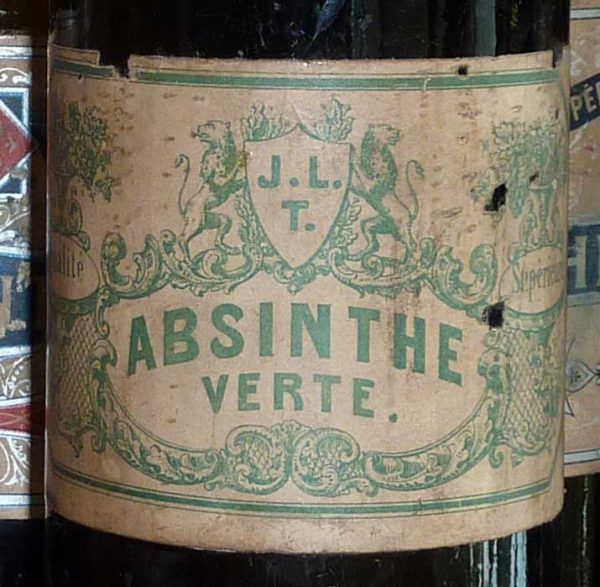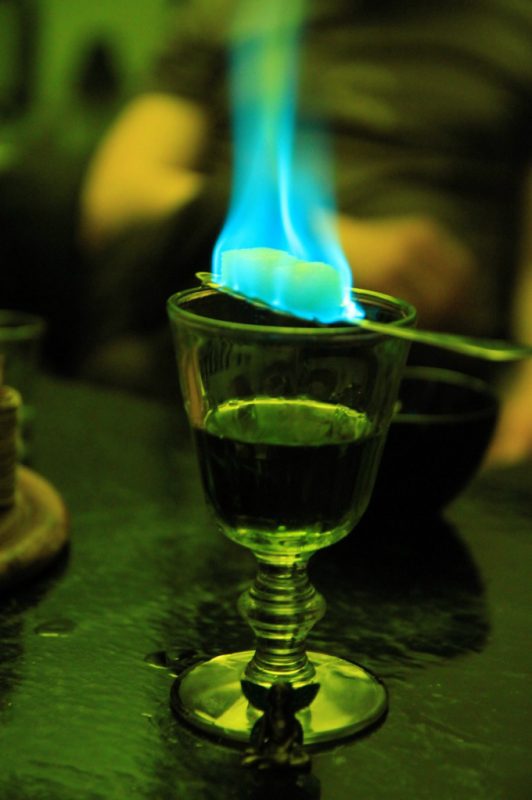In the same way that cold water adds to absinthe’s characteristic cloudy louche, dubious information clouds the perception of the green liquor. Its century-long ban resulted from misrepresentation and industry sway.
The story goes the Dr. Pierre Ordinaire prepared tonics. Absinthium, also known as grand wormwood, had a history as a remedy for indigestion, menstrual cramps, jaundice and bad breath. However, it was terribly bitter. Though use of various seeds, he tempered the flavor and gave the elixir its distinct green. He gave the recipe to the Sisters Henriod of Couvet, Switzerland. We know that in 1797, the sisters sold it to Daniel-Henri Dubied. He went into business with his son-in-law Henri-Louis Perenod. They distilled Dubied Pere et Fils. In 1805, Perenod renamed the distillery to Pernod.
It developed into a brand name. Absinthe had no legal definition; so many companies were able to sell cheaper imitations. Asking for Pernod meant that you knew quality.
The tradition of mixing absinthe with cold water resulted from the Algerian Campaign of 1844-1847. The French government rationed absinthe to soldiers. They mixed it with the local water for its hygienic effects. The mix returned with them, along with the appreciation of the louche.
Beginning in the 1850s, an infestation decimated the European wine industry. English botanists returned from America with samples of American grapes. These were home to the phylloxera louse. The American vines were resistant, but not the European Vitis vinifera. Phylloxera spread throughout the 1870s and 1880s. French wine production dropped to 10 to 30 per cent of what it had been. Absinthe took the place of wine, which became too expensive through scarcity.
Bad science stood on the side of temperance and the jealous wine industry. Dr. Valentine Jacques Joseph Magnan of Paris’ Sainte-Anne asylum coined the term absinthism. He treated alcoholics and defined the effects that differentiated absinthe abusers. Worship of the Green Fairy could lead to epilepsy, insanity and birth defects. He derived his results from injecting animals with oil of absinthium, a poison.
Long-term bans resulted from the Absinthe Murder. A Swiss laborer named Jean Lanfray shot his wife, his two daughters and himself on August 28, 1905. He lived through the suicide attempt. What drove him to the act? It was a breakfast of wine and brandy followed by a lunch of wine, brandy, crème de menthe and a final two glasses of absinthe. Sure, it was the absinthe. Neutral Switzerland enacted its ban on October 7, 1910.
The French ban began in August 1914. Backed by the Temperance movement and the wine industry, it was also a ban on high-proof spirits. Entering WWI, they did not want a repeat of the besotted soldiers returning from the Algiers Campaign. For their spirits, troops received a ration of good, healthy wine.
A century later, we still fell victim to chicanery. In the 1990s, “absinthe” began a revival. As there was no legal definition, subpar versions came to market. They would not louche as absinthe should. As subterfuge, a new “tradition” was introduced. An absinthe spoon was placed over a glass, with a sugar cube on top. Absinthe would be poured over the cube. When the cube was soaked, it was ignited and dropped into the glass. When the flame died out, an apparent louche resulted. Before anyone attempts this, they really should think, “How good is the booze if I want to set if on fire instead of drinking it?”
I have Absinthe: the Exquisite Liquor (Wittels and Breax, Golden, CO: Fulcrum Publishing, 2017) to thank for much of the information, and the French wine industry to thank for attempting to bury the competition.



1 Comment.
Art Nouveau is one of my favorite times, absinthe is the dubious drink of the day, the crazy drink that goes with the smooth madness of streampunk.
In reference, I recommend the vision of these pages
https://www.decoenligne.org/style-deco-steampunk/
https://www.decoenligne.org/?s=art+nouveau
best regards